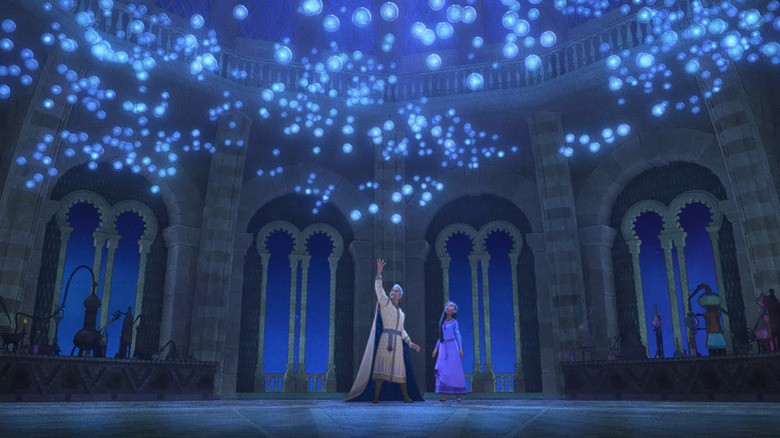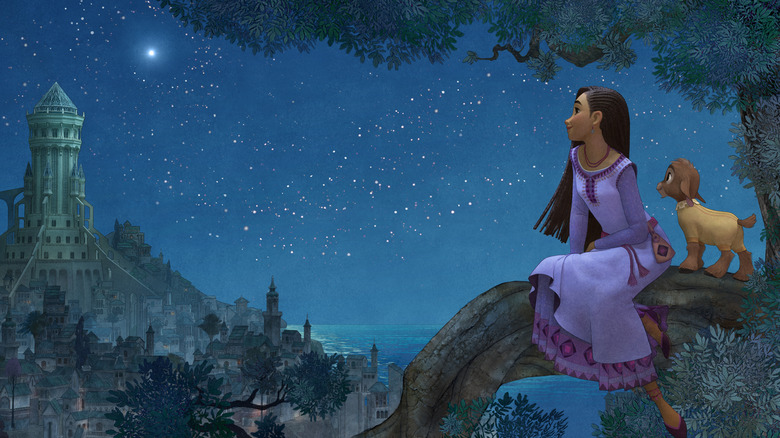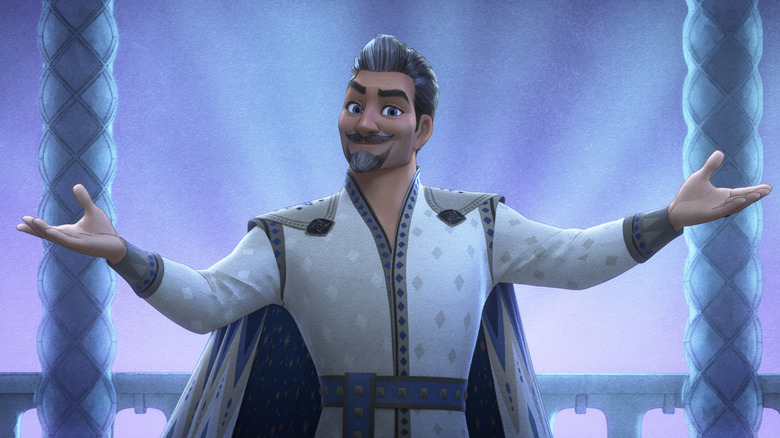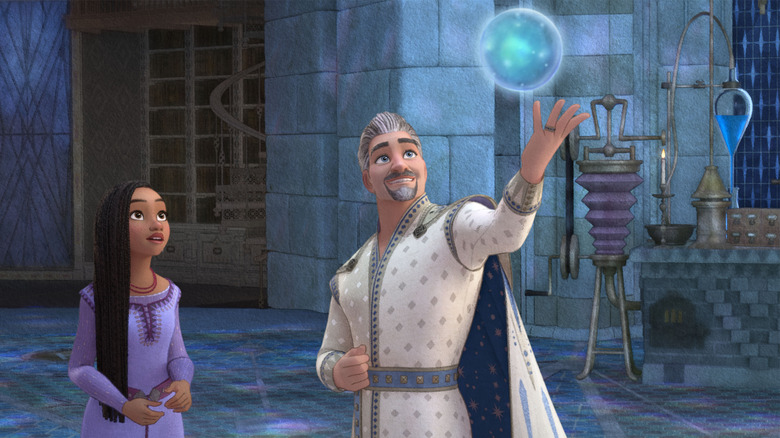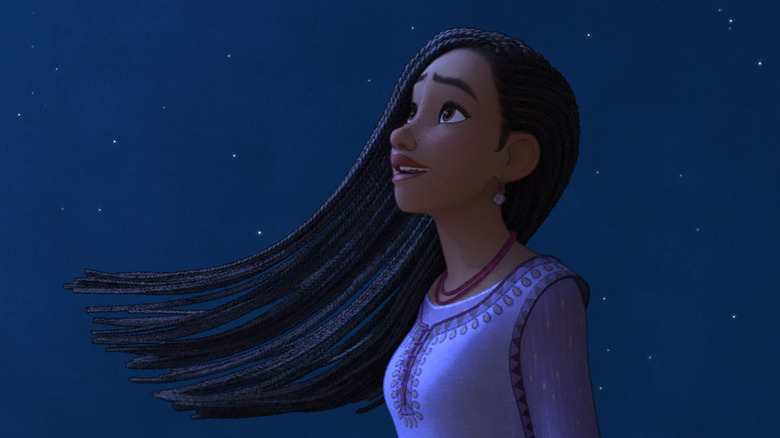Wish Directors Fawn Veerasunthorn And Chris Buck Reveal Their Wishes For The New Disney Film [Exclusive Interview]
Chris Buck has been working with Disney Animation for over 40 years, having worked as an animator on "The Fox and the Hound" and directing fan favorites like "Tarzan," "Surf's Up," and along with Jennifer Lee, both "Frozen" films. Fawn Veerasunthorn joined the Disney family with "Frozen," "Moana," and "Zootopia" as a storyboard artist, and later as head of story on "Raya and the Last Dragon." Now, she will make her directorial debut collaborating with Buck on "Wish." Billed as Disney's first original fairy tale and released during the studio's centennial year, "Wish" stars Ariana DeBose as Asha, a 17-year-old girl who finds a wishing Star that gives her the ability to grant wishes. However, she lives in the Kingdom of Rosas, a land ruled by King Magnifico (Chris Pine), who also has the ability to grant wishes but has made himself the arbiter of his citizens' hopes and dreams in the process.
There's certainly a lot of pressure for "Wish" to succeed, as many are viewing the film as the culmination of 100 years of Disney excellence. Fortunately, that's precisely the approach the filmmakers took to create the look and feel of the story. By utilizing watercolor background techniques and CG animation, as well as pairing a veteran director with the next generation of Disney tastemakers, "Wish" is the cornerstone of Disney's historic past and dynamic future.
/Film was fortunate enough to talk with Buck and Veerasunthorn about "Wish" following a press presentation and they talked about what it was like to co-direct, working with Ariana DeBose and Chris Pine, and their wishes for "Wish."
Note: This interview has been lightly edited for clarity and brevity.
'What art style inspired Walt Disney?'
"Wish" is absolutely beautiful and the blending of artistic techniques is a feast for the eyes. How did you determine which animation styles were going to be used in which ways?
Buck: It came down to obviously the 100th anniversary film. How can we honor our legacy? Obviously, we love it so much, it's the reason we're here. Still, how do we do something that is of today and something contemporary and something that's pushing forward the art of animation? So it was a little bit of, "Can we get somewhat of a hand-drawn look?" but of course within the CG world. And just those quick little things about this would be our wish to make a movie that would honor that, the past and then the future. It was all our amazing technicians that just kept saying, "Well, we could try this and we could do this and we could do this." And they just kept pushing each other and showing us just incredible beautiful work.
Veerasunthorn: Our production design team said, "Let's go back to the very beginning, to 'Snow White.' What art style inspired Walt [Disney]?" That's how we arrived at the watercolor look. And also our production design team are the biggest geeks of "Sleeping Beauty." So they were like, "It would be great if we were able to get a very designy aspect of the way each frame looks." So we framed each shot specifically using the guideline of the turn of the century illustration, which I'm very excited about. And we'll be presenting this in Cinemascope. I can go as nerdy as you like in the Cinemascope aspect ratio, which, when you see it in the theater, I think it'll hit you with the beauty and the immersive experience of this look of the film.
'If you're going to sing with Barbra Streisand, you've got to have some skills'
During the panel, it was mentioned that Jennifer Lee often wrote after hearing Ariana DeBose speak, almost writing in her voice. At what stage in the process of working with these characters did you have the realization of, "Oh, this has to be Chris Pine," or, "Oh, this has to be Ariana DeBose"?
Buck: Well, Ariana, we met about a year before we even cast her and it was an early, early script, but our casting director knew where we were going with the character Asha, and she just set up a Zoom meeting and we got to meet her and you could just feel that incredible energy. And I think she might've still been filming "West Side Story." So then when we finally signed her on, it was just a week before she won the Oscar for "West Side Story." So it was all very lucky in that respect. But she's incredible. She just brings so much of herself, a lot of the characters we love when the actors are able to bring themselves to it. Chris is the same way. We had a design for Magnifico already, but Chris came in. So what's happening is we look at the design when we hear the voices, sometimes we'll cut together some sound bites and Chris' other movies, and put it against just the Magnifico drawings and you can tell if something's going to work. Of course, he has that charm. He's actually very funny. He could sing [like] crazy.
Veerasunthorn: He's a great actor, too. So [he's got] all those combinations.
Buck: One thing you may not know, which we didn't know either, we did a deep dive and we went on to YouTube and said, "Let's hear Chris singing." We knew he was in "Into the Woods," so he was great in that. But then we found a duet he did with Barbra Streisand. Like, what? If you're going to sing with Barbra Streisand, you've got to have some skills. Anyway, he was great. And like I said, he brought so much fun, and Jen [Lee] and Allison [Moore] also wrote to him. Once they heard Chris and they heard a few sessions, they're like, "Okay, we know exactly what would be perfect, how to write for Chris."
Yeah, when "Dungeons and Dragons" was coming out and they announced, "Chris Pine's the bard," everyone I knew was like, "Oh, that is perfect casting for him."
Buck: He's so good in that. I love that movie.
'It was a true partnership'
Fawn, this question's for you. As a first-time feature film director, how has this process been compared to your previous roles on other projects?
Veerasunthorn: It's been amazing to get to see the scene through from start to finish. Usually, I stop or we put it into production and I'm like, "Goodbye baby," and I see it at the wrap party. So this has been –
Buck: And then she blames us for ruining her work. No, I'm kidding. [laughs]
Veerasunthorn: [laughs] I think the biggest thing I learned is that I need to be open to other ideas. Amazing things can come from anywhere. And all the departments at Disney, they brought their A-game to this movie and the storyboards that we sent in it is the start. It's like the tip of the iceberg. Chris, you told me that. I need to say it out loud. "It is okay to change the work that I drew, which I didn't even think about. I'm like, 'Well, yeah, of course they would. Everyone makes everyone's work better,' but they need to hear it from you."
Buck: Yeah, that's true.
Veerasunthorn: Yeah.
Aw, I love that.
Veerasunthorn: Working with Chris, too, I have admired him for so many years.
Buck: Okay. That's enough. [laughs]
Veerasunthorn: That's going to embarrass him.
My next question might also embarrass, so let's see. Chris, as someone who has already so much experience as a feature director, how do you ensure that you're maintaining a collaborative directorial partnership rather than a master-apprentice sort of partnership?
Buck: Having worked with Fawn since the first "Frozen," she was a story artist on that, and then on "Frozen II," I knew Fawn, I knew her talent. I knew not only was she talented, but the way that she thought about the story and thought about the characters. So she just digs in and really wants to make it believable and make it feel right and just make everything fit together perfectly. So in a way, it was a relief. I had a partner that ... I have my own shortcomings and there are things that I could rely on her for that, too. I'm not a great story artist like she is. I can draw, and I'm an animator, but I don't have the cinematography skills and some other skills that she does, and the thinking. So for me, it wasn't like a mentor-mentee relationship. It was a true partnership.
Veerasunthorn: Thanks, Chris.
'That's what this movie is all about'
Disney movies are always known for a takeaway theme or moral, or in some cases, multiple messages. What are your hopes? What do you wish people take away from after they've watched "Wish?"
Veerasunthorn: I think what we're going for is not so much a moral, we're going for the feels that your wish is a powerful thing to have. To never forget the spark of hope you have inside you that allows you to take action towards what you want in life.
Buck: And my wish is that a person could be my age, even, but someone who may have given up on a wish where life got in the way or whatever it was, and they put their wish on hold, that they would come out of this movie and go, "You know what? I'm going to go for it. It's time." Because it is the deepest part of yourself that you want, a desire, that, if it's been there since you've been a kid, I think you really have to pursue it. I think you have to go for it and keep going and keep striving. That's what this movie's all about.
"Wish" arrives in theaters on November 22, 2023.
